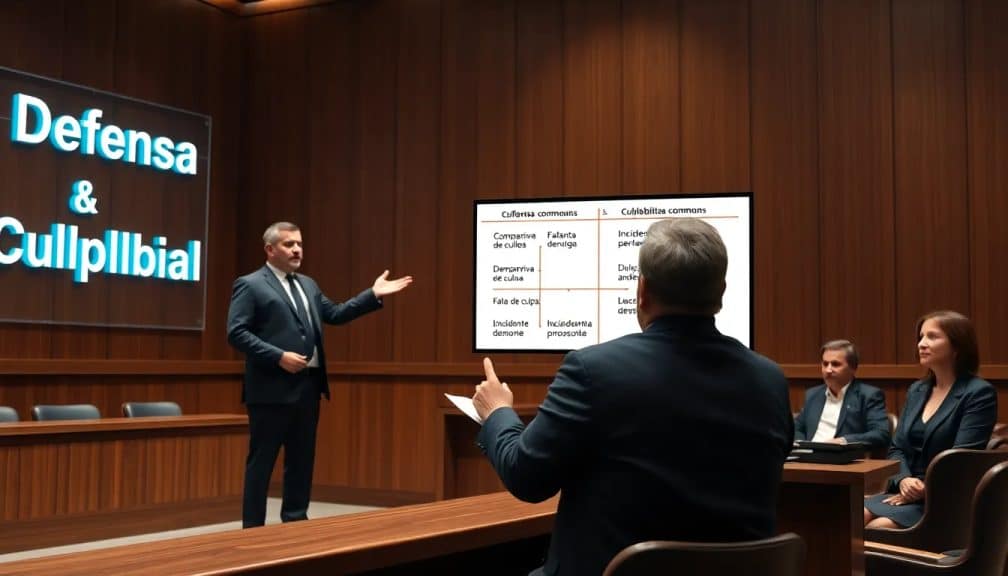When facing a personal injury claim, understanding the common defenses used in personal injury cases is crucial. Defendants often employ various strategies to minimize or dismiss the claims against them. This article explores these defenses in depth, helping injury victims navigate their legal options effectively.
What are the most common defenses in personal injury cases?
In personal injury litigation, several defenses are frequently raised by defendants. These defenses can significantly impact the outcome of a case.
- Contributory negligence: This defense suggests that the injured party's actions contributed to their own injuries.
- Comparative negligence: Similar to contributory negligence, but allows for a reduction in damages based on the percentage of fault attributed to the injured party.
- Assumption of risk: This defense claims that the injured party knowingly accepted the risks associated with a particular activity.
- Waivers of liability: Often used in cases involving recreational activities, these waivers can limit legal claims.
Each of these defenses serves a distinct purpose and can significantly alter the course of a personal injury lawsuit. Understanding these can prepare plaintiffs for the challenges they might face in court.
How does contributory negligence affect personal injury claims?
Contributory negligence plays a vital role in many personal injury claims. This legal doctrine asserts that if the injured party is found to be even slightly at fault, they may be barred from recovering any damages.
For instance, if a pedestrian is hit by a car while jaywalking, the driver could argue that the pedestrian's actions contributed to the accident. This could lead to the pedestrian receiving no compensation, despite the driver's negligence.
In states that adhere to contributory negligence laws, it's essential for plaintiffs to demonstrate that they were not at fault to secure compensation. This can be complicated, emphasizing the necessity of strong legal representation.
What is comparative negligence and how does it work?
Comparative negligence allows a more nuanced approach to liability in personal injury cases. Unlike contributory negligence, this doctrine permits recovery based on the degree of fault of all parties involved.
In jurisdictions that follow comparative negligence, the court assigns a percentage of fault to each party. For example, if the injured party is found to be 30% at fault for an accident, their compensation could be reduced by that percentage. Thus, if their damages amount to $100,000, they would only recover $70,000.
This approach not only recognizes the complexity of many accidents but also encourages parties to settle rather than go to trial. It can also significantly affect the strategy employed by both plaintiffs and defendants during litigation.
What defenses are based on pre-existing conditions?
Defendants may argue that the injuries claimed by the plaintiff are not due to the incident in question but rather a result of pre-existing conditions. This defense can undermine the credibility of the injury claim.
For example, if an individual with a history of back problems sustains an injury in a car accident, the defense might argue that the injury is related to their pre-existing condition rather than the accident itself. This can complicate the plaintiff's case, as they must provide evidence to differentiate between the new injury and any prior conditions.
To counter this defense, plaintiffs should gather comprehensive medical records and expert testimony to demonstrate how the incident exacerbated their existing conditions. This can help establish a clear link between the accident and their current injuries.
How does the statute of limitations impact injury claims?
The statute of limitations is a critical factor in personal injury claims, dictating the timeframe within which a lawsuit must be filed. Each state has its own laws regarding these time limits.
In most states, the statute of limitations for personal injury claims ranges from one to six years. If a claimant fails to file their lawsuit within this period, they may lose their right to seek compensation altogether. Therefore, it's essential to act promptly and consult with a personal injury attorney as soon as possible after an incident.
For instance, if an individual is injured in a slip-and-fall accident, they must file a claim before the statute of limitations expires. Understanding these laws can prevent costly delays that may jeopardize a legitimate claim.
What is the role of duty of care in personal injury defense?
Duty of care is a foundational concept in personal injury law, establishing the legal obligation one party has to another. In personal injury cases, the plaintiff must demonstrate that the defendant owed them a duty of care and that this duty was breached.
If the defendant can successfully argue that they did not owe a duty of care to the plaintiff, it can effectively shield them from liability. For example, in a car accident case, if a driver was not in violation of any traffic laws, they might argue that they did not owe a duty of care that was breached.
This makes it crucial for plaintiffs to establish the existence of duty and demonstrate how it was violated in order to prove negligence and secure a favorable outcome.
How can an experienced attorney help counter defense strategies?
Hiring a knowledgeable personal injury attorney can significantly enhance the chances of winning a case against various defenses. Their expertise allows them to effectively challenge the defenses presented by the opposing party.
An experienced attorney can gather critical evidence, such as witness testimonies and expert opinions, to refute claims made by the defense. They know how to navigate complex legal frameworks, including contributory and comparative negligence laws.
Moreover, a skilled attorney can craft a compelling narrative that illustrates the plaintiff's right to compensation, addressing each defense head-on. This proactive approach is crucial in countering common defenses used in personal injury claims effectively.
Related Questions about Common Defenses Used in Personal Injury Cases
What are the two defenses often used against liability claims?
The two most common defenses against liability claims are contributory negligence and comparative negligence. Both serve to limit the plaintiff's ability to recover damages based on their own actions in contributing to the injury.
In contributory negligence, if the plaintiff is found to be even minimally at fault, they may be barred from recovery. In contrast, comparative negligence allows for damages to be adjusted according to the percentage of fault attributed to each party, thereby providing a fairer outcome in many cases.
How to defend a personal injury claim?
Defending a personal injury claim involves presenting a solid case that counters the plaintiff's allegations. This can include demonstrating a lack of negligence, showing that the plaintiff contributed to their injuries, or asserting that the injuries predated the incident.
Effective defenses require thorough investigation, gathering evidence, and often expert testimony to support the defendant’s position. A well-prepared defense not only challenges the plaintiff's claims but can also shift the focus back on the plaintiff's actions during the incident.
What is the hardest injury to prove?
Soft tissue injuries, such as whiplash, are often considered among the hardest injuries to prove in personal injury cases. These injuries may not be visible on traditional imaging and can rely heavily on subjective reports of pain.
Proving such injuries requires a detailed medical history, expert opinions, and sometimes diagnostic testing that can be contentious in court. The lack of physical evidence can make it challenging to establish a clear link between the accident and the injury, complicating the plaintiff's case.
What is the burden of proof for personal injury?
In personal injury cases, the burden of proof lies primarily with the plaintiff. They must demonstrate that the defendant's negligence directly caused their injuries to recover damages.
This typically involves presenting a preponderance of evidence, meaning that it is more likely than not that the defendant's actions led to the harm suffered by the plaintiff. Successfully meeting this burden is essential for a favorable verdict.

